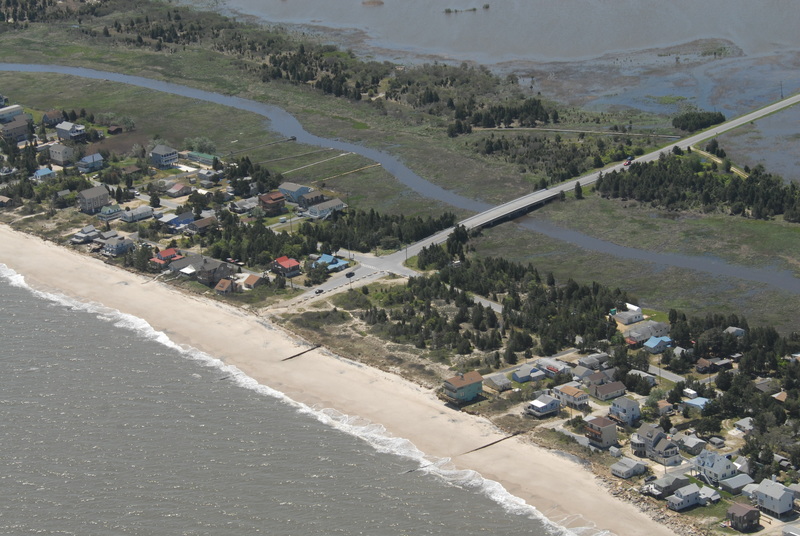Prime Hook National Wildlife Refuge officials publicly support one of three options for future refuge management in a recently released comprehensive conservation plan. The preferred alternative – referred to as Alternative B – would convert and maintain all four impoundments to saltmarsh and allow some beach replenishment. An inlet to the Delaware Bay near Fowler Beach would allow tidal flow into Unit 2 impoundment.
Based on feedback at ongoing workshops, many Delaware Bay town residents support Alternative C, which calls for constructing a substantial sand barrier with perpetual beach renourishment. It also calls for filling in breaches along the coast just north of Primehook Beach.
“We understand that some people – particularly those living in Primehook Beach – want the breaches filled in as soon as possible,” said Refuge Biologist Annie Larsen. “That's not the total answer, and we are trying to explain that, but it's tough to convince some people. We would like Unit 2 to look like Unit 1. We might have to do some beach replenishment and plug some breaches, but you can't plug all breaches without understanding the connection to the rest of the system.”
Unit 1 is now a thriving saltmarsh; Unit 2's marshes have been destroyed and the impoundment is nearly all open water.
Under the alternative preferred by federal officials, dredged material could be used to build up a base to plant vegetation such as spartina. In addition, berms would be constructed within Unit 2 to slow wave action and provide areas where sediment could build up. “Right now the water is too deep to grow anything,” Larsen said.
Stroeh said once the plan is approved, some short-term work such as building berms in Unit 2 could get under way in 2013 with major restoration work starting in 2014.
“We will be partnering with other agencies like the Army Corps of Engineers to get sediment at the least cost,” Stroeh said.
Dunes once offered protection of marshes
At one time, the refuge contained two freshwater and two saltwater marsh impoundments, which sustained a wide variety of fish, mammals, waterfowl and shorebirds. As a result of saltwater intrusion, Units 1 and 4 remain saltmarsh but Units 2 and 3 – once maintained as freshwater marshes – are now under constant siege from Delaware Bay saltwater.
Most of the 1,500 acres of Unit 2 are now converted to open water while saltwater, and saltwater is starting to cause major damage to the 2,500-acre Unit 3 impoundment.
Larsen said for 25 to 30 years, the duneline and beach provided sufficient protection to the marshes for refuge staff, using a water-control system, to maintain the delicate ecosystem of freshwater and saltwater wetlands unique to the refuge.
When nor'easters opened breaches in the duneline at Fowler Beach, in the northern section of the refuge, that balance was destroyed. Saltwater has been flowing into Unit 2 for the past three to four years destroying marsh plants and eating away at the protection once offered to nearby Primehook Beach.
Fowler Beach has eroded more than 500 feet over the past 85 years. Refuge Manager Michael Stroeh said so much beach erosion has occurred in the area that the property line has retreated from private land to refuge property. “The private land is now in the bay,” he said.
To make matters worse, Larsen said, the marsh has been sinking.
Residents say fill the breaches
At the June 9 meeting at the Milton Fire Hall, several Primehook Beach residents surrounded refuge staff with one thing on their mind. Using words like safety and danger, they said the breaches needed to be closed off with sand or even rocks or a seawall. They called for measures
Some residents said they are just one storm away from disaster, but refuge staff said high tides and storms can actually help the marsh in the long run by bringing in sand from the bay floor.
“We didn't want this to happen, and it would be difficult to go back to the status quo, which is not sustainable for the long term,” Larsen said.
As the hearings wrap up, the public has until Monday, Aug. 6, to comment on the conservation plan. Larsen said all comments are taken into consideration.
Larsen said refuge staff has been playing catchup to understand the drastic ecological changes occurring at Prime Hook. “Everything has happened so quickly, it's made our heads spin,” she said.
ALTERNATIVE A
Marshes, climate change: No active management of wetlands affected by recent changes along the refuge shoreline to allow for natural ecological processes to proceed without human intervention.
Hunting: Maintain the refuge's current hunting program with no turkey hunt; continue fee-based permit system; maintain permanent hunting structures; and provide pre-season lottery hunt for deer only.
Farming: No agricultural management of upland fields that were once farmed. Over time, the fields will transition to shrubs and thickets and then to woodlands.
Nuisance species: No action except to work with U.S. Department of Agriculture to control resident Canada geese, including lethal control.
ALTERNATIVE B
Marshes, climate control: Restore salt marsh impoundments in portions of the refuge's former freshwater ponds. The use of dredged material may be used.
Hunting: Increase number of hunt days and areas; eliminate permit hunting fees except for lottery hunts; phase out permanent hunting structures such as deer stands and duck blinds; offer a turkey hunt; and allow for pre-season lottery hunts for waterfowl and deer.
Farming: No agricultural management of upland fields with restoration of previously farmed and other open fields to native forest.
Nuisance species: Use a variety of methods such as fencing and behavior modification to control nuisance species such as Canada geese, snow geese and mute swans. As a last resort, allow lethal predator control to help endangering piping plovers and other rare nesting birds.
ALTERNATIVE C
Marshes, climate control: Return to former management conditions by building a barrier island capable of sustaining freshwater marshes in light of sea-level rise and climate change. This action would require construction of a substantial sand barrier that would need perpetual beach nourishment.
Hunting: Increase the number of hunt days and areas; eliminate fees except for lottery hunts; phase out permanent hunting structures; provide opportunities for pre-season lottery hunts for waterfowl and deer; no turkey hunt offered.
Farming: Upland fields previously enrolled in the cooperative farming program would once again be managed through farming practices with the cooperation of local farmers.
Nuisance species: No action except to work with U.S. Department of Agriculture to control resident Canada geese, including lethal control.
ABOUT PRIME HOOK
The 10,133-acre refuge stretches along the west shore of Delaware Bay 22 miles south of Dover. Eighty percent of the refuge is tidal and freshwater wetlands and 20 percent consists of upland habitats. The refuge was established in 1963 primarily to preserve coastal wetlands as wintering and breeding habitat for migratory waterfowl.
Final hearing scheduled for Tuesday, June 19
The long-awaited 1,200-page Prime Hook refuge draft comprehensive conservation plan was released May 31. The formal public hearing is 6-9 p.m. Tuesday, June 19, at Cape Henlopen High School, 1250 Kings Highway, Lewes.
The refuge will also have one more open house from 1-4 p.m. on Sunday, June 17, to answer questions regarding the plan. The refuge is located on Turkle Pond Road east of Route 1 outside Milton.
Comments on the plan can be made at the hearings or by mail, fax and e-mail with a deadline of Monday, Aug. 6. Addresses and numbers are: northeastplanning@fws.gov; 413-253-8468; Thomas Bonetti, U.S. Fish and Wildlife Service, 300 Westgate Center Dr., Hadly, MA 01035.
Copies of the plan can be downloaded at fws.gov/northeast/primehook or ask for a copy on CD-ROM from refuge staff at 302-684-8419 or at the above email address.





















































